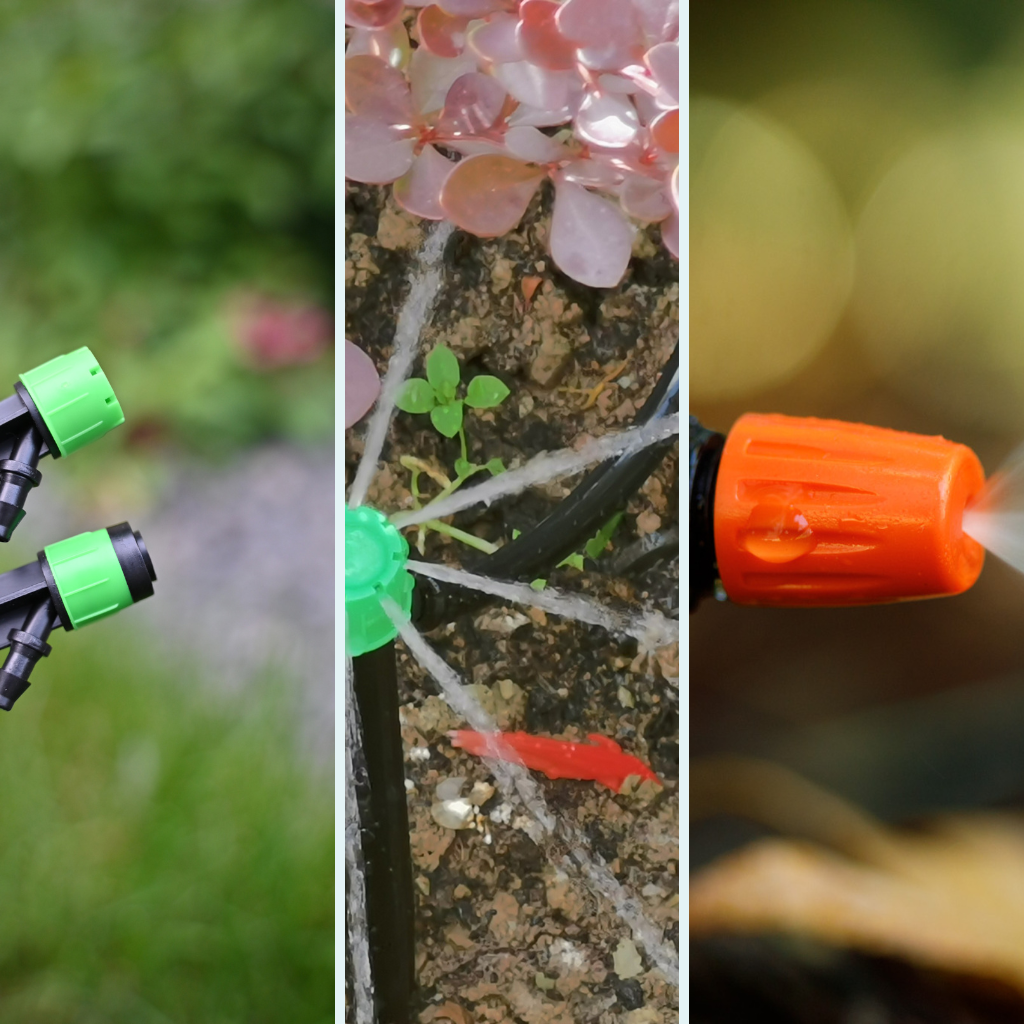
Choosing the right emitters transforms your garden’s watering efficiency. This guide explains flow rate, shows how to match it to plant needs, and compares the main drip irrigation emitters available — including Carpathen’s options and how they fit your plants' needs.
What Is Flow Rate & Why It Matters
Flow rate measures how much water an emitter releases, usually in gallons per hour (GPH). The right flow reaches roots evenly without runoff or underwatering. In practice, most home beds land in the 1–3 GPH range per emitter, then adjust by soil, plant size, and weather.
Quick tip: If the surface puddles, lower GPH or split watering into two shorter pulses. If soil is dry 2–3″ down right after a cycle, raise GPH slightly or extend minutes.
| Emitter Type | Flow Range (GPH) | Water Delivery | Typical Use |
|---|---|---|---|
| Drip (Point-Source) | 0.5–2.0 | Slow, steady drops at the root zone | Pots, herbs, raised beds |
| Vortex (Adjustable Spray) | 1.0–4.0 | 360° spray or gentle trickle | Flowers, vegetables, shrubs |
| Mist (Push-to-Connect Kit) | ~1.0–2.0 | Fine mist cloud for delicate foliage | Seedlings, microgreens, humidity-lovers |
| Spray/Bubbler (market) | 2.0–10+ | Broader spray / high volume | Trees, hedges, landscape zones |
Matching Flow Rate to Plant Type
Plants “drink” at different speeds. Seedlings appreciate gentle, frequent moisture; fruiting crops thrive on deeper soaks. With adjustable emitters, you set a baseline, observe the soil, then fine-tune a quarter turn at a time.
| Plant Type | Recommended Flow (GPH) | Emitter Type | Frequency |
|---|---|---|---|
| Seedlings & Tender Herbs | 0.5–1.0 | Drip or Mist | Daily |
| Flowers & Ornamentals | 1.0–2.0 | Vortex | Every 2–3 days |
| Vegetables (Tomatoes, Peppers) | 2.0–3.0 | Vortex | Every 1–2 days |
| Shrubs & Perennials | 2.0–4.0 | Vortex | Every 2–4 days |
| Small Trees | 4.0+ (or multiple emitters) | Vortex | Weekly |
Water Efficiency & Absorption
Efficient irrigation isn’t just “how much water.” It’s how water moves through your soil profile and whether roots can take it up. The goal is steady infiltration without puddling, with moisture reaching active roots (often 6–8″ for veggies) and leaving a reserve until the next cycle.
Three forces that decide efficiency
- Soil intake rate: Sandy soil drinks quickly (safe to run higher GPH for shorter minutes). Clay absorbs slowly (use lower GPH and pulse cycles).
- Root depth & density: Shallow-rooted herbs need frequent, light watering; deep-rooted crops prefer fewer, deeper sessions.
- Weather & exposure: Heat, wind, and full sun increase demand; shade and cool temps decrease it.
Pulse watering outperforms one long soak
Try two short runs with a 15–30 minute pause. The first wets the surface and starts infiltration; the pause prevents runoff; the second pushes moisture deeper without flooding.
Clay example: ~1–1.5 GPH. Run 8 minutes → pause 20 minutes → run 8 minutes. Even moisture, no puddles.
Sandy example: ~2.5–3 GPH. Run 12 minutes in the morning; add a 6–8 minute top-up on very hot days.
Diagnostics to fine-tune quickly
- Finger test (2–3″): After watering, soil should feel cool and moist, not muddy. Dry? Increase minutes or GPH.
- Spade core (6–8″): Slice out a wedge — the middle should be damp. If only the top is wet, add a second pulse.
- Runoff watch: If water travels away, lower GPH, shorten runs, or add a pause.
Carpathen’s adjustable drip irrigation emitters make these tweaks easy — turn down for new transplants or rainy weeks, turn up during fruit set or heat waves.
Plant-by-Plant Hydration Playbook
Use these field-tested starting points, then dial with the diagnostics above. Values assume mulched beds and average conditions; shift up in heat/wind and down in cool/shade.
Herbs & Tender Seedlings
| Examples | Emitter | Flow (GPH) | Minutes | Sessions/Week | Notes |
|---|---|---|---|---|---|
| Basil, cilantro, lettuce starts | Drip or Mist | 0.5–1.0 | 6–10 | 5–7 | Keep top 2–3″ evenly moist; avoid soggy media. |
| Microgreens/trays | Mist (PTC kit) | ~1.0–1.5 | 3–6 | 5–7 | Short bursts prevent damping-off. |
Leafy Greens & Brassicas
| Examples | Emitter | Flow (GPH) | Minutes | Sessions/Week | Notes |
|---|---|---|---|---|---|
| Kale, chard, spinach | Vortex (gentle) | 1.0–2.0 | 10–14 | 3–5 | Even moisture keeps leaves tender. |
| Broccoli, cauliflower | Vortex | 1.5–2.5 | 12–16 | 3–4 | Increase during head formation. |
Fruiting Vegetables
| Examples | Emitter | Flow (GPH) | Minutes | Sessions/Week | Notes |
|---|---|---|---|---|---|
| Tomatoes (staked/indeterminate) | Vortex | 2.0–3.0 | 14–20 | 3–4 | Deep, steady moisture reduces blossom end rot. |
| Peppers, eggplant | Vortex | 2.0–3.0 | 12–18 | 3–4 | Don’t let soil fully dry between fruit sets. |
| Cucumbers, squash | Vortex | 2.0–3.5 | 12–18 | 3–4 | Mulch to stabilize moisture. |
Root Crops
| Examples | Emitter | Flow (GPH) | Minutes | Sessions/Week | Notes |
|---|---|---|---|---|---|
| Carrots, beets, radishes | Drip or Vortex (low) | 0.75–1.5 | 10–14 | 3–5 | Even top-to-mid moisture prevents forking/splitting. |
| Potatoes | Vortex | 1.5–2.5 | 12–16 | 3–4 | Increase during tuber bulking; avoid oversaturation. |
Ornamental Flowers & Perennials
| Examples | Emitter | Flow (GPH) | Minutes | Sessions/Week | Notes |
|---|---|---|---|---|---|
| Marigold, petunia, zinnia | Vortex | 1.0–2.0 | 10–14 | 2–4 | Shallow rooters — consistent top moisture. |
| Hydrangea, daylily | Vortex | 2.0–3.0 | 12–18 | 2–3 | Hydrangeas like reliable, even moisture. |
Shrubs & Small Trees
| Examples | Emitter | Flow (GPH) | Minutes | Sessions/Week | Notes |
|---|---|---|---|---|---|
| Roses, blueberries | Vortex | 2.0–4.0 | 16–24 | 2–3 | Multiple emitters per plant improve coverage. |
| Dwarf fruit trees | Vortex (2+ per tree) | 3.0–4.0 each | 20–30 | 1–2 | Place emitters at the drip line, not the trunk. |
Succulents & Mediterranean Herbs
| Examples | Emitter | Flow (GPH) | Minutes | Sessions/Week | Notes |
|---|---|---|---|---|---|
| Lavender, rosemary, thyme | Drip (low) | 0.5–1.0 | 6–10 | 1–2 | Let the top inch dry between sessions. |
| Agave, aloe (containers) | Drip (very low) | ~0.5 | 4–6 | Every 10–14 days | Ensure fast-draining mix. |
Containers & Raised Beds
| Setup | Emitter | Flow (GPH) | Minutes | Sessions/Week | Notes |
|---|---|---|---|---|---|
| Small pots (8–12″) | Drip | 0.5–1.0 | 6–10 | 4–7 | Containers dry quickly — check daily in summer. |
| Large planters (14–22″) | Vortex (low) | 1.0–2.0 | 10–14 | 3–5 | Add a second emitter for mixed plantings. |
| Raised beds (mixed veg) | Vortex + Drip (barbed mixed kit) | 1.5–3.0 | 12–18 | 3–5 | Use vortex for area coverage, drip for thirsty anchors. |
All Carpathen emitters are adjustable. Start conservative, verify soil at 6–8″ depth, then nudge minutes or GPH in small steps.
Types of Drip Emitters (Market Overview)

Vortex Emitters
Swirling chamber resists clogging and delivers a 360° adjustable spray or gentle trickle.
Drip (Point-Source) Emitters
Precise drops at the plant base for pots and raised beds.
Mist Emitters
Fine cloud for seedlings and humidity-loving greens.
Spray/Bubbler Emitters (market)
Broader spray or high-volume options exist in the wider market for landscaping.
Side-by-Side Comparison
| Feature | Vortex (Carpathen) | Drip (Carpathen) | Mist (PTC Kit) |
|---|---|---|---|
| Flow Range | 1–4 GPH (adjustable) | 0.5–2 GPH (adjustable) | ~1–2 GPH (adjustable) |
| Delivery | 360° spray / trickle | Point-source drops | Fine mist cloud |
| Coverage | Medium–wide | Narrow | Narrow, gentle |
| Best For | Flowers, veg, shrubs | Pots, raised beds, herbs | Seedlings, microgreens |
| Clog Resistance | High (turbulent) | Moderate | Moderate (keep water clean) |
| Carpathen System | Barbed & Push-to-Connect | Barbed (mixed kit) | Push-to-Connect only |
Soil Type & Flow Guidance
| Soil Type | Flow (GPH) | Tips |
|---|---|---|
| Sandy | 2–4 | Quick drainage; short, more frequent sessions |
| Loamy | 1–2 | Balanced; easy to dial and maintain |
| Clay | 0.5–1.5 | Slow intake; use pulse watering to avoid puddles |
Carpathen System Compatibility

Push-to-Connect System
- Emitters Adjustable drip, vortex and mist emitters (mist available only as part of this kit)
- Tubing 1/4"
- PSI 20–45 PSI
Standard System
- Emitters Vortex and drip spray, all adjustable
- Tubing 5/16" mainline + 1/4" branches
- PSI 20–45 PSI
Coverage notes:
-
Drip = point-source coverage focused at the root zone, typically creating a wetting area of about 2–8 inches in diameter depending on soil texture and flow rate. Ideal for pots, raised beds, and any plant that benefits from precise watering with minimal overspray/evaporation.
-
Vortex = adjustable 360° spray/trickle for general area coverage around small to medium plants.
-
Mist = ultra-gentle, leaf-friendly fine cloud for seedlings and humidity-loving greens.
Standalone Emitter Kits (Carpathen)
(Sold separately in addition to being included within the systems above.)
-
Drip Irrigation Emitters Vortex – 100 pcs, 1/4" barbed, mini hole punch included
-
Use with barbed setups. High-quantity pack for beds and borders.
-
-
Drip Irrigation Emitters Mix – 12 pcs, 1/4" (adjustable drip + accessories)
-
Compact barbed starter/mix pack suited to planters and small beds.
-
-
Drip Irrigation Emitters Vortex – 30 pcs, 1/4" push-to-connect
-
Quick-connect (push-to-connect) pack for fast installs and modular layouts.
-
All Carpathen emitters are adjustable. Start conservatively, check soil at 2–3″ (surface) and 6–8″ (root zone), then fine-tune minutes or GPH in small steps.
Smart Watering Schedules
- Water in the morning to reduce evaporation.
- Use pulse cycles (two shorter runs with a pause) for better absorption.
- Adjust frequency with seasonal weather and plant growth stage.
- Timers + adjustable emitters = consistent results with minimal effort.
Charts: Flow Rate & Efficiency
Flow Rate by Plant Type (Suggested Ranges)
Bars show relative flow range bands. Adjust within each band for your soil and weather.
Water Efficiency vs. Flow Rate
Efficiency typically peaks around 1–3 GPH with pulse scheduling and good soil contact.
FAQ
Are “drip emitters” and “drip irrigation emitters” the same thing?
Yes — “drip irrigation emitters” is simply the longer phrase for the same components that release water to plants in a drip irrigation system.
Which emitters does Carpathen include in each system?
Push-to-connect: adjustable vortex, drip srpay and mist emitters (mist available only within this kit).
Barbed: an adjustable vortex and drip kit that combines adjustable drip + vortex emitters.
What flow rate should I start with?
Begin around 2 GPH, run 15–20 minutes, and check soil 2–3″ down: puddles → lower flow or split into pulses; dry → raise flow slightly or extend minutes.
Can I mix emitter types on one line?
Yes. The Carpathen barbed mixed kit is designed for exactly that — point-source drip where precision matters and adjustable vortex for area coverage.
What pressure do Carpathen emitters prefer?
Both systems operate best at 20–45 PSI. Staying in this range keeps flow consistent and connections secure.
How do I limit clogging?
Use clean water, add filtration if needed, and flush lines periodically. Vortex emitters naturally help resist clogging via internal turbulence.
How do I adapt through the season?
All Carpathen emitters are adjustable — turn down during cool/rainy weeks and increase during heat waves or heavy fruiting stages.
Conclusion

“Every plant’s specific hydration need” becomes manageable when you match flow rate to soil and root depth, then fine-tune with short diagnostic checks. Start in the 1–3 GPH sweet spot for many beds, pulse when needed, and adjust a quarter-turn at a time. Your plants — and your water bill — will thank you.
Tip: Revisit your settings at the start of each season. Two minutes of tuning today saves hours of rescue watering later.



